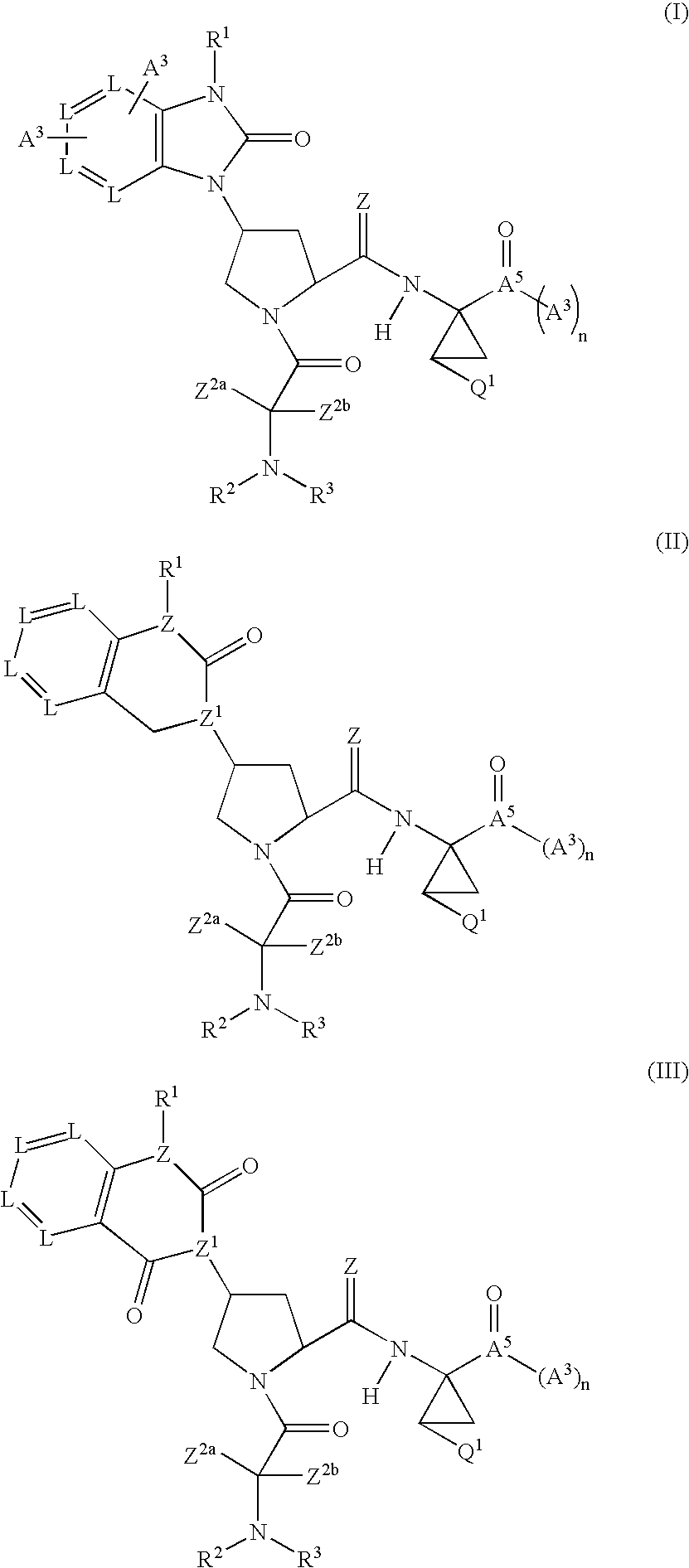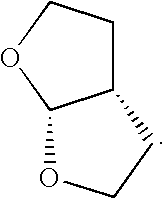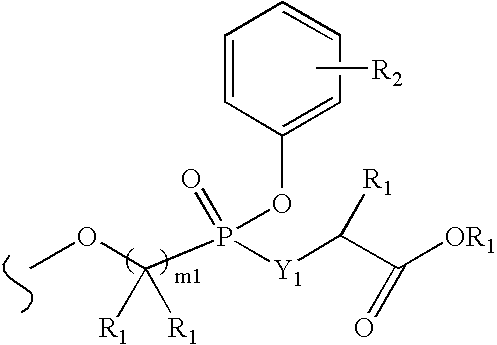Antiviral compounds
a technology of antiviral compounds and compounds, applied in the field of antiviral compounds, can solve the problems of difficult or inefficient intracellular targeting, difficult or inconvenient development of effective methods, and many attempts to develop effective methods
- Summary
- Abstract
- Description
- Claims
- Application Information
AI Technical Summary
Benefits of technology
Problems solved by technology
Method used
Image
Examples
example 111
Preparation of Compound 111
[0544]
[0545] Step 1. Aminoproline (8 g, 34 mmol) and nitrobenzaldehyde (15 g, 102 mmol) were taken up in ethyl acetate (200 mL) in a 500 mL round bottomed flask. The reaction was stirred with a magnetic stirrer at room temperature. Sodium cyanoborohydride (6.4 g, 102 mmol) and acetic acid (6.1 mL, 102 mmol) were added and the reaction was allowed to stir at room temperature for 15 h. The reaction mixture was then quenched with saturated sodium bicarbonate solution and the layers separated. The organic layer was washed with brine, dried with sodium sulfate, and concentrated. Purification was performed via flash chromatography (hexanes / ethyl acetate) to provide 5 g (40% yield) of the desired nitrobenzyl adduct. This product was then taken up in ethanol (100 mL) in a round bottomed flask, and activated palladium on carbon (10%) was added. The flask was then charged with hydrogen gas and stirred for 2 hours at room temperature. The reaction mixed was then fil...
example 112
Preparation of Compound 112.
[0551]
[0552] Step 1. To a solution of carboxylic acid (500 mg, 1.03 mmol) in dichloromethane (8 mL) was added HATU (585 mg, 1.54 mmol), 4-methylmorpholine (395 μL, 3.59 mmol), the TFA salt of the amino ester (191 mg, 1.23 mmol) and the resultant solution was allowed to stir at room temperature for 16 hours. The reaction mixture was diluted with dichloromethane (50 mL), washed with water (20 mL), saturated sodium bicarbonate (20 mL), saturated ammonium chloride (20 mL), dried (Na2SO4), purified by silica gel chromatography (eluted with 50% EtOAc in hexanes) to supply the tripeptide as a white solid (545 mg, 0.87 mmol, 85%). 1H NMR (300 MHz, MeOD) δ 0.96-1.02 (m, 11H), 1.19 (t, J=7 Hz, 3H), 1.35-1.39 (m, 1H), 1.53-1.75 (m, 9H), 2.09-2.26 (m, 2H), 2.37-2.42 (m, 1H), 3.93-4.13 (m, 4H), 4.25-4.50 (m, 3H), 4.56-4.75 (m, 1H), 4.96-5.16 (m, 2H), 5.18-5.24 (m, 1H), 5.67-5.79 (m, 1H), 6.73-6.76 (m, 1H), 6.85-6.90 (m, 1H), 7.06-7.13 (m, 2H). LC-MS 624 (M++1).
[0553...
example 113
Preparation of Compound 113.
[0554]
[0555] Step 1. The tripeptide (300 mg, 0.48 mmol) was dissolved in dimethylformamide (15 mL) and cooled to 0° C. Cesium carbonate (729 mg, 2.24 mmol) and iodomethane (84 μL, 1.34 mmol) were subsequently added and the reaction mixture was then allowed to stir to room temperature for 3 hours. The reaction mixture was diluted with ethyl acetate (100 mL), washed with water (50 mL), saturated ammonium chloride (50 mL), dried (Na2SO4), purified by silica gel chromatography (eluted with 50% EtOAc in hexanes) to supply the desired compound as a white solid (64 mg, 0.10 mmol, 21%). 1H NMR (300 MHz, MeOD) δ 0.96-1.02 (m, 11H), 1.19 (t, J=7 Hz, 3H), 1.35-1.39 (m, 1H), 1.53-1.68 (m, 9H), 1.99-2.26 (m, 2H), 2.35-2.42 (m, 1H), 3.30 (s, 3H), 3.97-4.24 (m, 4H), 4.28-4.42 (m, 3H), 4.55-4.77 (m, 1H), 4.93-5.19 (m, 2H), 5.07-5.25 (m, 1H), 5.67-5.70 (m, 1H), 6.92-6.99 (m, 2H), 7.20-7.28 (m, 2H). LC-MS 638 (M++1).
[0556] Step 2. To a solution of the methylateted cyclic...
PUM
| Property | Measurement | Unit |
|---|---|---|
| Composition | aaaaa | aaaaa |
Abstract
Description
Claims
Application Information
 Login to View More
Login to View More - R&D
- Intellectual Property
- Life Sciences
- Materials
- Tech Scout
- Unparalleled Data Quality
- Higher Quality Content
- 60% Fewer Hallucinations
Browse by: Latest US Patents, China's latest patents, Technical Efficacy Thesaurus, Application Domain, Technology Topic, Popular Technical Reports.
© 2025 PatSnap. All rights reserved.Legal|Privacy policy|Modern Slavery Act Transparency Statement|Sitemap|About US| Contact US: help@patsnap.com



